Open-ground open day that was a milestone
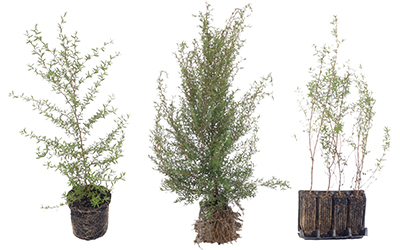
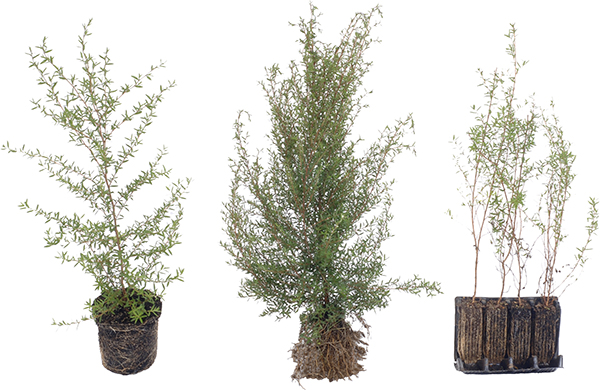
Spot the Difference: Mahurangi mānuka grown in, left, plastic pot, middle, open-ground bed, and, right, in root trainer. photographer Jonathan Barran
Milestone has become a somewhat devalued word.
The open-ground open day at Taupō on Saturday was one of the stages that are termed milestones in the project’s contract with the Sustainable Farming Fund. Some of the milestones are rather minor, but not this one—it was a stage, and an event. It was the project’s first full-scale crop of open-ground seedlings ready to be harvested, and involved the coming together of 40 individuals and representatives intensely interested in better ways of establishing indigenous trees.
The only way the open day could have been more dramatic would to have timed it for the lifting of the plants, which is underway as this report is published. However, it was not contemplated as would have placed a totally unreasonable logistical pressure on Taupō Native Plant Nursery and the planting contractors back in the Mahurangi—maybe once the system has been bedded in for a few years the players will want to be that flashy!
But more than a milestone, Saturday may also prove to have been an historic event. There have been two large-scale land use transformations in post-European Aotearoa:
- From indigenous forest to pasture
- From pasture to exotic forest.
While New Zealanders are justifiably proud of both these achievements, there is now an urgent imperative for a third large-scale land use progression:
- From pasture and exotic forest to sustainable indigenous forest.
By large-scale, is not for a moment meant to imply all, or most. Apart from the economic powerhouse that is dairy, Aotearoa has a moral duty to continue as a gross exporter of food—as do all parts of the planet that can produce food surplus to the requirements of the people of their region.
However, the highways between Taupō and Rotorua are lined with large new dairy farms, on land that was recently producing timber. The methane contribution to the atmosphere—and methane is more deleterious greenhouse gas than carbon dioxide—and the nitrate contribution to the lakes, makes this a particularly problematic change in land use.
The morning session
By the time the northern contingent arrived, only a few minutes late—makes note, 5 am at Mahurangi West for 10 am at Taupō is about right as long as time is not lost looking in Huapai for Chris at number 66 and Kim at number 77, rather than visa versa!
The packing shed used for the gathering resembled a half price plant sale. A number of unwitting customers made the same mistake and had to be directed to the nursery’s retail section.
There was still ample time for cups of coffee and introductions, and home-baked biscuits remaining.
Dr David Bergin, who confesses to loving the informality of such workshops, warmly welcomed the 40-odd souls and outlined the day’s programme. The packinghouse doors were rolled down to keep out the deteriorating weather.
David, throughout the morning, wove the discussion together, providing facts and figures as called upon.
Open-Ground Indigenous Plants
Open-Ground Indigenous Plants project manager Cimino Cole told how Auckland Regional Council studies to benchmark a catchment with little urban development had instead shown the harbour going to hell in a handcart.
The five-year Mahurangi Action Plan was the regional council’s timely response. However, the advice of ex soil conservator Mike Vine, based on the Rotorua Lakes experience, was to think long-term—‘We have been at it for 30 years, and it looks as thought it will take at least another 30!’.
And the long-term strategy called for trees, trees and more trees.
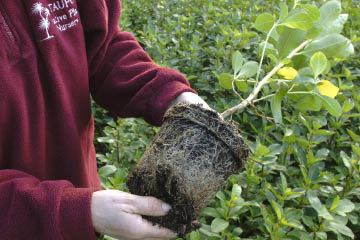
Familiar Phenomena: Container-grown karamū displaying the excessive root circling that can condemn a tree to premature catastrophic failure—perhaps not critical in a shrub, but a dead loss in the case of a sustainable timber tree. photographer Jonathan Barran
Open-ground guru
Over-use by information technology types, means that guru is up there with milestone and icon.
But Jaap van Dorsser’s career with the Forest Research Institute, and his work in the 1960s and 1980s adapting open-ground methods for raising indigenous species squarely justifies Jaap being termed the open-ground guru.
Jaap proceeded to describe and demonstrate the physiology of plants.
Most illuminating to the layperson is the realisation of the importance of the root system. While this should come as no surprise, Jaap, by shaking the media out of plant after plant delivers a graphic lesson, including demonstrating his method of summarily shearing off malformed and circled roots of container-grown plants.
Jaap’s demonstration also leaves an impressive pile of debris!
Silviculture bullet
While the high cost of plants is a part of the reason indigenous trees are excessively expensive to establish, maintenance thorough to canopy closure—the point at which weeds are largely beaten—is another substantial cost.
Chris Ferkins described how by making every other plant a toetoe—not pampas—canopy closure is achieved within nine months. Not only that but the toetoe does a better job than mulch to provide a habitat for indigenous fauna.
The toetoe serves just a transitional function, and dies out after being over-topped by the interspersed woody species.
There may be no single silver bullet to bring down establish costs but toetoe, along with open-ground plants, could form part of the ammunition.
Tāne’s Tree Trust
The open day was co-sponsored by Tāne’s Tree Trust, which helped ensure the substantial turnout.
Trust chairman Ian Barton spoke to a PowerPoint presentation titled: Why it exists, what it does, why it does it. He said the trust had made good progress with it objectives:
- Building a network of knowledge sharing amongst stakeholders
- Establishing a database of past incomplete research projects for benefit of future researchers and establishing new research projects
- Resolving taxation, legal and political obstacles which act as disincentives to the planting of indigenous trees
- Maximise economic incentives by reducing establishment costs.
With the exception of the last one—reducing establishment costs.
Cimino Cole suggested that, being a national body, the trust may be ideally positioned to head up the on-going open-ground trials and develoment.
Eighty-one million to play with
An unanticipated but extremely pertinent contribution was that of Lake Taupō Protection Trust chief executive Graeme Fleming, who explained the trust’s work encouraging and assisting land use change to reduce the nitrogen impact the lake.
The trust’s funding of $81 million over 15 years comes from the Ministry for the Environment, Environment Waikato and the Taupō District Council—it is clearly hoped that by spending large sums now, Taupō can avoid going bottom up in the manner of the Rotorua Lakes.
While Graeme Fleming spoke, every person present must have been marvelling at how germane the open-ground project was the goal of assisting land use change, whether it be for two-tier farm forestry, sustainable indigenous timber production or pure indigenous restoration. Subsequently, Dr David Bergin has discussed the open-ground project with Graeme Fleming and protection trust director John Kneebone.
Sustainable Farming Fund
Helen Percy, the project’s Sustainable Farming Fund advisor, was introduced.
The open-ground project will have corrected any misconception held by attendees that the agriculture and forestry ministry’s sustainability fund is only about farming—high time it was renamed the Sustainable Agriculture and Forestry Fund.
Action plan milestone
The open-ground project was a direct response to the harbour’s elevated sediment accumulation rate, but bizarrely was initially attacked by Auckland Regional Council’s then rural land management team leader—under the misapprehension than indigenous plants could not be bare-rooted.
Consequently, the whole-hearted participation by Mahurangi Action Plan project leader, Kim Morresey, in the open day was a milestone in itself.
Emissions trading
Ministry of Agriculture and Forestry’s Patrick Hawinkles was last up, charged with the tall order of explaining which credits applied to trees planted when and under what circumstances, and given only a short amount of time in which to do it—lunch was smelling good on the barbecue and the temperature was plummeting.
It would be nice to report that Patrick was successful and that everyone was soon au fait with the intricacies of the sustainable forestry schemes, but the subject demands fierce concentration of the mind—the saving grace was a flowchart that shows how they fit together.
Only those accustomed to Dr David Bergin’s hands-on approach to science would have been unsurprised that son and field assistant, Michael, and youngest daughter Natalie, were responsible for laying on the hearty fare of sausages and salad in bread rolls, and more home-baking.
To cloak the land in native trees
In its slogan, Taupō Native Plant Nursery has nicely evoked the Māori feather cloak.
It is axiomatic that the steep erodible Mahurangi harbourscape needs its cloak of indigenous forest restored. Certainly there is room for exotic trees like olives and for grape vines, but much of the harbourscape terrain is so steep that only a substantial forest canopy will sufficiently tame the surface flows—the surface flows that carry soil inexorably into the harbour, smothering much of the fauna that should be thriving there.
The un-acclimatised northern attendees could have used a feather cloak each, as additional insulation from the Taupō cold and wet, as the forty filed off for a tour of nursery.
Philip Smith explained the propagating facilities and the efforts the nursery makes to provide eco-sourced plants, and the importance of planning if eco-sourcing is to be deliverable—an opportune time to also stress the greater degree of planning bare-root methods require—the plants having a finite life once lifted from the open-ground nursery beds.
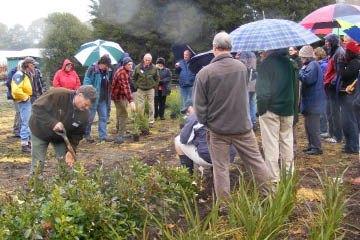
No Shortage of Samples: Philip Smith digs up another open-ground plant to demonstrate the consistently vigorous root growth. photographer Cimino Cole
Standing on open-ground
While reversing the order of proceedings would have avoided standing in light rain and near-freezing temperatures, saving the best till last—seeing open-ground plants lifted and compared with the siblings grown in pots and root trainers—was bountiful reward.
The bulk of the foliage open-ground plants overwhelmed that of the container-grown stock. “It is this foliage,” said Jaap van Dorsser, “that is the engine room that drives the root growth, once planted.”
Methodical measurements taken earlier of the trial plants, by Michael Bergin and Tare Karae, show an average open-ground stem thickness of about twice that of the container grown plants.
While these results are hugely encouraging, the real test comes after the plants are established at the restoration sites—both at the time of canopy closure and after a decade or two.
Recapitulation
The programme had provided for coffee and recapitulation back at the packing shed but what was on everybody’s mind clearly involved more warmth and stiffer beverage.
The northern contingent spent the night near Ngongotahā, at the Waitetī Trout Stream Holiday Park, owned by former Friends of the Mahurangi executive member, Michael Thorne.
Michael is a dutiful and generous host, thinking to check the party had sufficient wine—given the good cheer evident while the venison meat balls and bolognaise were being prepared. ‘Yes, thank you very, very much—so long as David Bergin arrives soon with more!’
Which of course he did, and a marvellously animated discussion of restoration planting ensued, ranging all the way from Rodney District Council’s flawed roadside vegetation control regime, to the unsuitability of marram grass for Stewart Island’s foreshore—dune restoration is a big part of David’s work.
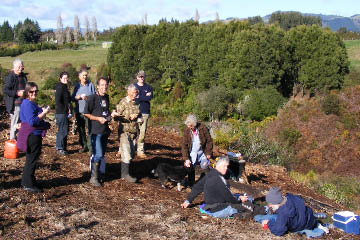
Disconvolvulation: The northern contingent visit Jaap and Sue van Dorsser and other members of the team reclaiming the Awahou River’s riparian margins from blackberry and convolvulus, and replanting with ‘disconvoluted’ plants. photographer Cimino Cole
The morning after
The reason for stopping-over, and at Ngongotahā, was to visit Jaap van Dorsser’s massive riparian restoration project on the nearby Awahou River.
The riparian margin of Jaap and Sue van Dorsser’s property, and that of their neighbours, was retired by Environment Bay of Plenty in the 1980s—part of efforts to save Lake Rotorua. Much of the riparian protection work carried out then was a disaster. The riparian margins soon became avenues of convolvulus and blackberry. But not even the planted indigenous trees that did establish and survive were safe. Jaap has a comprehensive collection of stumps that graphically demonstrate how planter bag-induced root circling condemned tree after tree to eventual catastrophic failure—through root strangulation or inadequate bracing afforded by a convoluted root system. Jaap’s forestry ethos prohibits planting any plant that has a compromised root system—every plant has its planting media shaken out and any deformed or elongated roots pruned. None of this would be necessary had the work Jaap did with the Forest Research Institute not been discontinued.
It can be rationalised that the failure of a tree to reach its full potential, in a restoration planting scenario, is not fatal to the broad objective of re-establishing indigenous vegetation. However, container-grown plants are not cheap and nor is the process of tending them until the battle with invasive weeds is won.
Meantime, Chris Ferkins and Jaap plan a trial planting without bare-earthing the site beforehand—an objective that also benefits from the availability of large, vigorous open-ground plants.
Making some scientific history
Tomorrow morning, Taupō Native Plant Nursery will deliver a truckload of over 3000 plants to the first trial site, on Shelley Trotter’s property in Sandspit Road.
Dr David Bergin and Michael Bergin will be on site doing the exacting job of setting out the randomised planting plan so that a comparison between how well indigenous plants raised open-ground, and those container-grown, establish can be objectively recorded—for the first time ever.
See also Open-Ground Indigenous Plants Report
